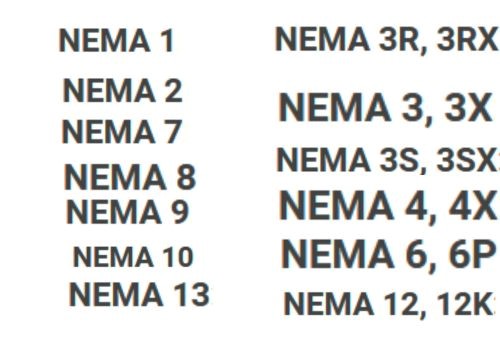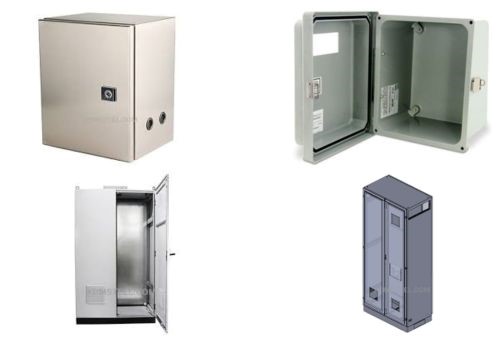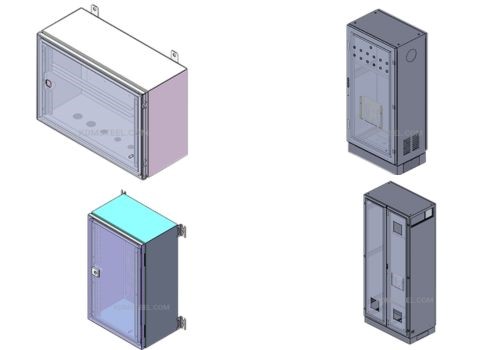Every electrical enclosure is designed to meet specific safety, protection and environment standard. It is the NEMA ratings that outline these critical standards in the electrical enclosure manufacturing.
In this guide, we will explore all fundamental aspects about NEMA rated electrical enclosures.
From listing all standards, exploring benefits, specific application requirements to comparing NEMA to IP rating – this information will help you choose perfect electrical enclosure for your applications.
What is NEMA Rating in Electrical Enclosure?
NEMA ratings provide guidelines and standards an electrical enclosure should conform for any application.
For every degree of protection, there are numbers or a combination of numbers and letters. These numbers and letters tell the electrical enclosures the level of protection it offers.
They are from 1 to 13 depending on construction design, safety and degree of protection.

Importance of NEMA Enclosure Ratings
· Ensuring Safety
For safety, NEMA rating specify the expected levels of protection for all your electrical equipment in the electrical enclosure.
Thus, selecting the proper NEMA-rated enclosure eliminates potential electrical risks, including short circuits and fire, for both people and equipment. These ratings assist you in verifying that the enclosure is able to withstand the environmental test, thus minimizing failure possibilities.
· Protecting Equipment
It is effective to use NEMA-rated enclosures because they shield your equipment from dust, water, and many other worse conditions. It also lengthens the useful life of your electrical equipment and reduces the frequency of maintenance.
By choosing the right NEMA rating, the equipment functions as expected in the specific environment, be it indoors or outdoors.
· Compliance with Standards
NEMA ratings assist you in meeting NEMA guidelines and codes. These ratings offer a definitive guide to the protection degree necessary in specific applications, so your installations are legal and safe.
Following NEMA standards may also reduce the level of inspection and certification processes and assure you that your systems meet the set norms.
· Choosing the Right Enclosure
Helping you choose an appropriate enclosure for your application is something that NEMA ratings do. It is easy to determine the appropriate enclosure by going through the NEMA ratings. This helps to ensure that your electrical components are properly shielded, thus enhancing their performance and reliability.
· Enhancing Reliability
When an electrical device is housed in an NEMA-rated enclosure, you improve the dependability of the electrical systems. These enclosures are made specifically for a given set of conditions to guarantee that they are going to operate optimally in a given environment.
Such reliability reduces the probability of unexpected failure situations, allowing you to work constantly, thus reducing the impact of failures.
History of NEMA Standards for Electrical Enclosure
The history of the NEMA standard for electrical enclosures can be traced back to early 1926, when the National Electrical Manufacturers Association was formed.
NEMA was formed with the mandate of developing a standard framework for electrical products so as to guarantee safety, quality, and compatibility in the market. Prior to NEMA, the absence of conformity presented problems of interoperability and safety risks.
In the 1930s, it started defining specific standards for electrical enclosures according to the environmental and application differences. These standards gave specific information about how and with what kind of material enclosure should be constructed. Also, what protection should it afford for indoor, outdoor, or hazardous area usage, etc.
Since the adoption of the NEMA enclosure ratings chart, it has become easier for manufacturers, engineers, and consumers to determine which enclosure is appropriate for which application, thus increasing safety and reliability.
Different standards have been modified over the years to fit current changes and technologies and the arising needs of industries that use electrical products.
NEMA Rating Enclosure Types

1. NEMA 1 Electrical Enclosure
These enclosures are usually made from metal or plastic and have relatively simple construction with the provision for air vents. The enclosure protects the equipment from light, dust and accidental touch among others. You would use the NEMA 1 type of enclosure, where the risk of exposure to dust and light moisture is relatively low.
These enclosures help protect electrical elements from touching and small objects. They might interfere with its operation, making it safe and durable for use in controlled indoor settings.
2. NEMA 2 Electrical Enclosure
The NEMA 2 electrical enclosure protects components from dripping and light splashing of non-corrosive liquids. Intended for indoor applications, NEMA 2 packaging units may be installed in utility basement areas where casual light degrees of watering are feasible. These enclosures are sealed with gaskets and seals in order to keep water out of the circuits.
With the use of the NEMA 2 enclosure, you are able to keep the electrical part dry and safe. This increases its lifespan and also its safety in slightly harsh indoor conditions.
3. NEMA 3 Electrical Enclosure
Based on the features that include Watertight, Ice resistance, Sleet and Windblown dust, the NEMA 3 electrical. The use of enclosure is best when used outside of the home. These are normally made from corrosion-resistant materials such as stainless steel or coated steel and incorporated with provisions like weep holes. You would use a NEMA 3 enclosure in an outdoor environment like a construction site or agriculture field.
4. NEMA 3R Electrical Enclosure
A NEMA 3R electrical enclosure is totally enclosed for outdoor use but does not afford any protection against the entrance of dust. These enclosures are normally applied in areas where wind-borne dust is not a challenge, for instance, in telecommunications or utility purposes.
These enclosures are made from materials such as galvanized steel or aluminum and have sloped roofs and weep holes for drainage. With this NEMA electrical enclosure, all your components are free from rain, sleet and ice.
5. NEMA 3S Electrical Enclosure
The NEMA 3S electrical enclosure has extra weather resistances such as rain, sleet, windblown dust, and ice buildup. To allow for the usage of external mechanisms even when ice forms, NEMA 3S enclosures are also frequently constructed. Such enclosures are made from materials such as aluminum alloys or other materials that are highly resistant to corrosion.
They have provisions such as good sealing and weeping. Therefore, you would apply a NEMA 3S enclosure for industrial or utility occasions where equipment has to function under a snow shroud.
This makes certain that your electrical system is not only sufficient but also constructed to work optimally even in unfavorable outdoor conditions.
6. NEMA 4 Electrical Enclosure
It is resistant to rain, wind-blown dust, splashing water, and hose-directed water, and is made especially for indoor and outdoor use. These enclosures are made using stainless steel or coated metals and also feature sealed gaskets to avoid water entry. You would apply a NEMA 4 enclosure where equipment is subjected to washdowns or extreme weather.
This may include food processing industries or severe atmospheric conditions. Hence, when you decide to select a NEMA 4 enclosure, you are guaranteeing durability and increasing the safety of your electrical parts.
7. NEMA 4X Electrical Enclosure
When it comes to corrosion resistance, a NEMA 4X electrical enclosure is better built than a NEMA 4 electrical enclosure. Because of this, it can be employed, particularly in areas with corrosive chemicals, such as chemical industry and areas close to the ocean.
There are two basic materials from which NEMA 4X enclosure cases originate: stainless steel and fiberglass-reinforced polyester. Looking at the NEMA 4X enclosures, it protects components from chemicals alongside other undesirable environmental conditions.
8. NEMA 5 Electrical Enclosure
These enclosures offer better protection from falling dirt. Besides, it offers protection from non-corrosive coolants, water and oil, among others.
These are used in textile mills or paper product manufacturing plants that produce certain dust in aerosol form. Constructed from solid and durable materials, it has a sealed gasket.
Some of the NEMA 5 enclosures help protect the electrical parts from moisture or other contaminants. Your equipment can operate safely and effectively in areas where dust and mild dampness are a problem with a NEMA 5 enclosure.
9. NEMA 6 Electrical Enclosure
A NEMA 6 electrical enclosure is sealed for hose-directed water, temporary immersion at limited depth, and external ice. These enclosures are produced in stainless steel or plastic with a compact or sealed gasket. You would use a NEMA 6 enclosure in places where equipment could sometimes be exposed to water, such as in floods or water industries.
Choosing a NEMA 6 enclosure means that electrical systems will remain operational while safely protected from water, which improves their durability.
10. NEMA 6P Electrical Enclosure
High levels of water and even concurrent underwater operation at preset levels are protected against by the NEMA 6P electric box. They are waterproof to a certain extent; this is the kind that is submersible for a short time. These enclosures are suitable for both internal and external attachment and can be made of stainless steel or plastic with additional sealed gaskets.
You would use the NEMA 6P enclosure where equipment gets exposed to constant water immersion, like in marine or subway systems. Thus, choosing the NEMA 6P enclosure will maximize the level of protection and operational stability in severe environments for your electric utilities.
11. NEMA 7 Electrical Enclosure
The purpose of the NEMA 7 electrical enclosure is to prevent the spread of hazardous gasses and protect against possible interior explosions. Built out of cast aluminum or cast iron, these NEMA 7 housings have tight, watertight seals and tight, secure closures. A NEMA 7 enclosure is applied in places such as oil refineries or plants where there are chances of explosive gases and vapors. It is preferable to go for a NEMA 7 enclosure for maximum safety, bearing in mind that tackling hazardous areas requires higher standards.
12. NEMA 8 Electrical Enclosure
Designed to be used in dangerous environments, NEMA 8 electrical enclosures stop combustible gasses or vapors from exploding in the surrounding air. You can confine the explosion within the enclosure. Made of strong metals such as cast aluminum or cast iron, NEMA 8 enclosures come with features such as tight clamping and explosive-proof sealing. NEMA 8 is applied in sectors such as petrochemical and pharmaceutical production, making sure that the electrical devices are secure.
13. NEMA 9 Electrical Enclosure
NEMA 9 electrical enclosures are designed for use in hazardous locations that have been classified as Class II Division 1 Groups E, F, or G. Commonly made from materials such as cast aluminum or cast iron, it provides a tight seal and fastening points to isolate any internal explosions. They are suitable for use in grain processing or textile mill environments to make sure that electrical systems are safe in locations with combustible dust.
14. NEMA 10 Electrical Enclosure
Mine Safety and Health Administration’s (MSHA) recommend NEMA 10 enclosures. These cases offer safety in dangerous mining conditions as they shield the electrical parts from explosive gases, dust, and hazards related to mining. NEMA 10 enclosures are built from high-quality, explosion-proof materials with robust sealing systems and tight fastening mechanisms.
15. NEMA 12 Electrical Enclosure
When used inside, NEMA 12 enclosures provide protection from falling objects, non-corrosive liquids pouring, moving airflow, other conveyed bulk material or dust, etc. These enclosures are usually made of steel or plastic and are provided with sealed gaskets for the exclusion of contaminants. You would use a NEMA 12 enclosure in industries like manufacturing or processing industries where dust and water are found. The NEMA 12 enclosure allows you to avoid the negative effects of the environment on the electrical components, keeping them in good working condition.
16. NEMA 13 Electrical Enclosure
These are specifically suited for use in oil and coolant conditions, and enclosures are protected from any dripping or splash of oil or coolant. These enclosures are suitable for use in machine shops or industrial areas where oil or coolant is likely to be in use.
Made of steel or plastic and having strong gaskets, NEMA 13 enclosures protect electrical parts from contamination and moisture. By choosing NEMA 13, you are guaranteed that your electrical services will not fail in different indoor environments that come face-to-face with fluids.

Comparing the IEC 60529 Standard and the NEMA Electrical Enclosure Rating
· Scope of Protection
What you will discover is that IEC ratings are based mostly on protection from solid objects and water. However, extra features that NEMA ratings include are corrosion, gaskets, and environmental factors such as oil and coolant.
This broader scope ensures that your electrical enclosures are well protected in various situations.
· Testing Methods
Tests for dust and water ingress are very different for IEC ratings and give exactly this information. NEMA ratings include a wider range of tests that mimic actual environmental conditions such as mechanical abuse and end-of-life. This means your enclosures are long-lasting and sturdy.
· Geographical and Industrial Use
IEC ratings are commonly used all over the world, especially in Europe. NEMA ratings are mainly applied in North American countries, especially in the industrial field. Based on your geographical location and area of operations, you will select the standard most suitable for your business.
· Practical Applications
If you need more detailed information about dust or water resistance, IEC ratings could help. For an overall evaluation of the rigidity and resistance of an enclosure to tough atmospheric conditions, you should go for NEMA ratings. This helps ensure that you have the right protection measures for your electrical components.
NEMA Enclosure Rating vs. IP Enclosure
NEMA and IP (Ingress Protection) ratings are both used to classify the level of protection offered by electrical enclosures.
Comparing NEMA enclosure ratings and IP ratings, one will realize that NEMA has more to provide than IP wider coverage against the risk. Whereas IP ratings are focused solely on dust and water ingress.
NEMA ratings are extensively used for industrial applications across North America, while IP ratings are used globally recognized, notably in Europe.
Understanding both standards allows you to choose the best enclosure for the safety and dependability of your electrical systems. However, there are some key differences.
| NEMA Rating for Electrical Enclosure | An Equivalent IP Rating to Electrical Enclosure |
| NEMA 1 | IP20 |
| NEMA 2 | IP22 |
| NEMA 3 | IP54 |
| NEMA 3R | IP24 |
| NEMA 3S | IP54 |
| NEMA 4 | IP66 |
| NEMA 4X | IP66 (with added corrosion resistance) |
| NEMA 5 | IP52 |
| NEMA 6 | IP67 |
| NEMA 6P | IP68 |
| NEMA 7 | No direct equivalent (explosion-proof) |
| NEMA 8 | No direct equivalent (explosion-proof) |
| NEMA 9 | No direct equivalent (explosion-proof) |
| NEMA 10 | No direct equivalent (MSHA) |
| NEMA 12 | IP52 |
| NEMA 13 | IP54 |
FAQs
How does NEMA 1 and NEMA 2 Enclosure Compare?
Designed for indoor use, NEMA 1 and NEMA 2 offer basic protection against dust (NEMA 1) and dust with some seeping water. With NEMA 2, you get slightly better moisture resistance.
What is the difference between NEMA 4 and NEMA 12 Enclosure?
NEMA 4 is meant for outside application, providing protection from rain, dust, and splashing water.
NEMA 12 offers only a restricted level of protection against the infiltration of dust and dirt and is designed for indoor use. Significantly better weatherproofing is offered by NEMA 4.
Conclusion
As you can see, NEMA rating offers protection for all environmental conditions and situations. Depending on your unique applications requirements, you electrical enclosure manufacturer will design and configure systems that meet specific NEMA requirements.
At KDM, we help you get safe, reliable and NEMA compliant electrical enclosures – contact us now for more inquiries.
More resources:
NEMA 4 vs 4X Enclosures – Source: KDM
NEMA 7 vs. NEMA 4X – Source: KDM




